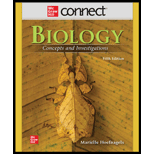
Concept explainers
To determine:
The tissue in which it is expected to find the radioactive material immediately after exposure to the labeled carbon and during transport if a scientist has exposed a leaf to
Concept introduction:
Phloem sap is the organic compound consisting sugars, amino acids, hormones, enzymes water and minerals. The sugar is mostly dissolved carbohydrates like sucrose. It is synthesized at source part of the plant. The source parts of the plant are capable of synthesizing sugars in the presence of sunlight by the process of photosynthesis. The photosynthetic cells present in leaves are capable of photosynthesis. Thus, phloem cells originate in the photosynthetic cells only.
Want to see the full answer?
Check out a sample textbook solution
Chapter 23 Solutions
BIOLOGY:CONCEPTS+INVEST.-CONNECT ACCESS
- Under what conditions does plant tissue experience lack of oxygen? How is ATP generated from glucose without oxygen?arrow_forwardPredict what will happen to the transportation of water and minerals through the plasma membrane if the root was poisoned and no cellular respiration occurredarrow_forwardIn winter, plants exchange the saturated lipids in their membranes for unsaturated lipids. Unsaturated lipids are "bent" and keep the membranes more fluids because they cannot be stacked closlely together. Of what advantage would this be for herbaceous plants that live through the winter? (Hint: what happens to bacon grease or the grease on top of soup when you put it in the refrigerator?)arrow_forward
- Which of the following membrane activities requires energy from ATP hydrolysis? Group of answer choices water uptake of plants from roots to shoots movement of water using aquaporin absorption of dissolved nutrients in the small intestine transport of oxygen through the phospholipid layerarrow_forwardPlant leaves contain openings called stomata, which allow the diffusion of ?arrow_forwardFigure 2 shows the cross-section of a eudicot root. i. Based on Figure 2, identify the structure that regulates the movement of water and minerals towards the xylem in the root. ii. Name structure of the cell membrane allows it to act as a selective barrier? iii. Predict what will happen to the transportation of water and minerals through the plasma membrane if the root was poisoned and no cellular respiration occurredarrow_forward
- A flask containing an aquatic plant in water is placed next to a light. A sensor that detects the amount of dissolved oxygen is placed in the flask, and the light is set on a timer to run on a 12-hour-light, 12-hour-dark cycle for 48 hours. Explain how the amount of dissolved oxygen will change in the flask during the 12-hour-light cycle Support your explanation using information about the processes that are occurring in the flask.Explain how the amount of dissolved oxygen will change in the flask during the 12-hour-dark cycle. Support your explanation using information about the processes that are occurring in the flask.arrow_forwardDescribe the journey of a carbon atom. Begin with it as atmospheric CO2 and end with it as part of a cell wall molecule in a root. Describe a) the structures through which the C atom moves, b) the reason it moves, and c) any cellular process with which it is involvedarrow_forwardWhat prevents plant cells from bursting when they are placed in hypotonic surroundings?arrow_forward
- Using the diagram below, explain the flow of energy and how the chloroplasts and mitochondria work together to make ATP (useable energy for the cell).arrow_forwardTerrestrial plants have stomata on the surface of their leaves. Stomata are surrounded by two guard cells that change shape in response to environmental factors and open or close the stoma. Which of the following best explains how the structure of the leaf is used in processes that occur in plants? A. Water enters the plant through the surface of the leaf for transpiration B. Gases for photosynthesis are exchanged through the surface of the leaf. C. Energy for cellular reproduction is absorbed through the surface of the leaf. D. Carbon dioxide enters the plant through the surface of the leaf for cellular reproduction.arrow_forwardWhich statement about C4 and CAM plants is TRUE? C4 and CAM plants have an additional carbon fixing enzyme C4 and CAM plants have reduced rates of cellular respiration. C4 plants separate initial carbon fixation from the light reactions There are no TRUE answers A pineapple is a C4 plant, agave is a CAM plant C4 plants open their stomata only at nightarrow_forward
 Biology: The Dynamic Science (MindTap Course List)BiologyISBN:9781305389892Author:Peter J. Russell, Paul E. Hertz, Beverly McMillanPublisher:Cengage Learning
Biology: The Dynamic Science (MindTap Course List)BiologyISBN:9781305389892Author:Peter J. Russell, Paul E. Hertz, Beverly McMillanPublisher:Cengage Learning

